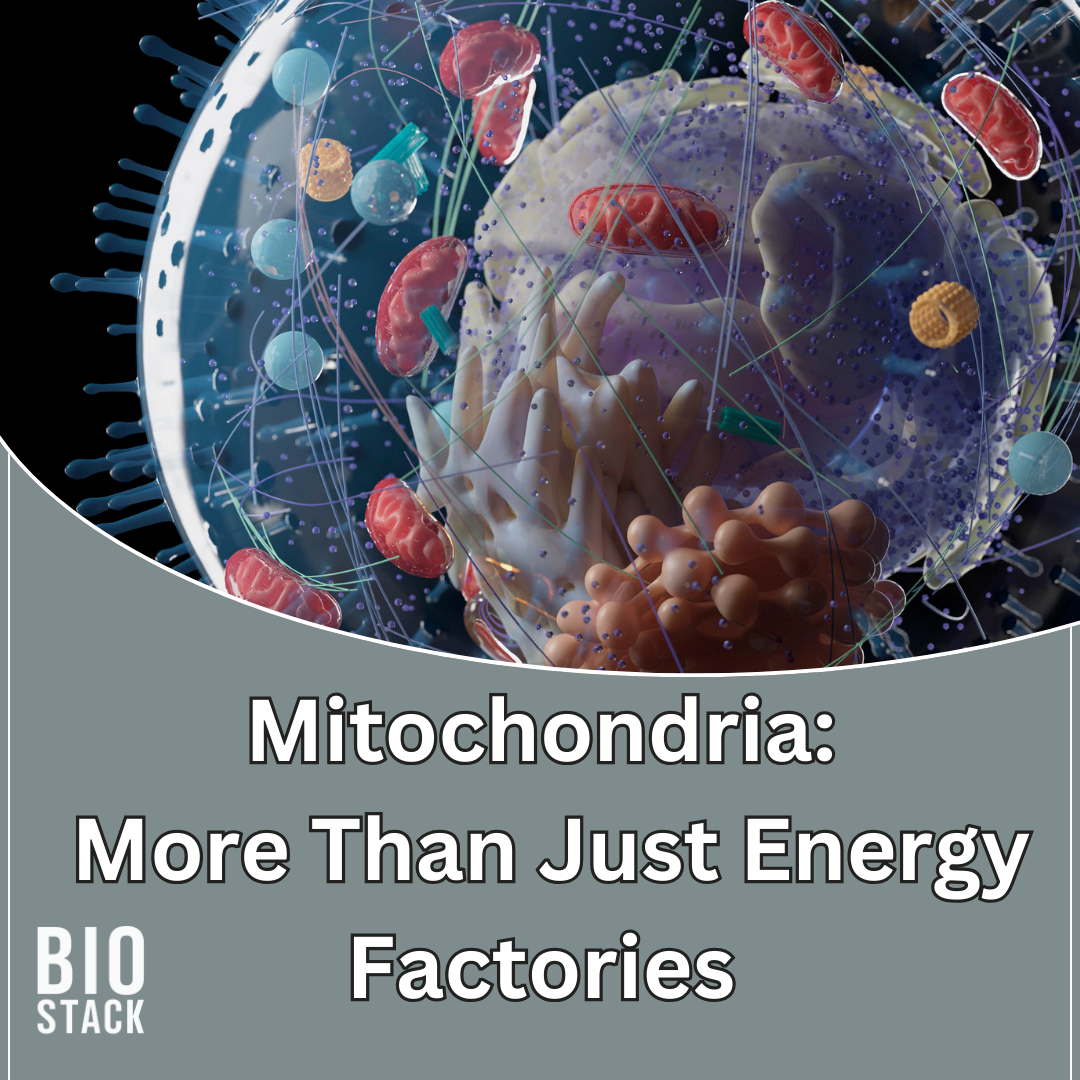
Mitochondria: More Than Just Energy Factories
Share
Mitochondria: More Than Just Energy Factories
Mitochondria are often referred to as the “powerhouses” of cells, a role that cannot be overstated. However, the scope of mitochondrial function extends far beyond energy production. These tiny, double-membraned organelles are central to various biological processes, including cellular signalling, apoptosis (programmed cell death), calcium homeostasis, and the generation of reactive oxygen species (ROS). Understanding the broader role of mitochondria in health and disease highlights their importance in maintaining cellular function and overall organismal well-being. Additionally, mitochondrial health is intricately tied to the coenzyme nicotinamide adenine dinucleotide (NAD+), a molecule that plays a crucial role in energy metabolism, cellular repair, and aging.
The Structure and Primary Function of Mitochondria
Mitochondria have a unique structure that allows them to perform their diverse functions. They consist of an outer membrane, which encases the organelle, and an inner membrane that is highly folded into structures known as cristae. These cristae increase the surface area for the mitochondrial inner membrane, where key reactions of cellular respiration occur.
The primary function of mitochondria is to generate adenosine triphosphate (ATP), the cell’s energy currency. This is achieved through a process called oxidative phosphorylation, which occurs in the electron transport chain (ETC). In this process, electrons derived from nutrients such as glucose and fatty acids are passed along a series of protein complexes within the inner mitochondrial membrane. The energy released from these electrons is used to pump protons (H+) across the inner membrane, creating an electrochemical gradient. This gradient drives the synthesis of ATP by the enzyme ATP synthase. Without this process, cells would be unable to meet their energy demands.
Beyond Energy: Other Crucial Roles of Mitochondria
While ATP production is fundamental, mitochondria are involved in numerous other vital processes that contribute to cellular health and function.
-
Calcium Homeostasis: Mitochondria play a critical role in regulating intracellular calcium levels. Calcium is an essential signalling molecule that influences various cellular processes, including muscle contraction, neurotransmitter release, and enzyme activity. Mitochondria act as buffers, absorbing excess calcium from the cytosol to prevent toxic build-up. This helps maintain cellular function and prevents calcium-induced cell damage.
-
Apoptosis (Programmed Cell Death): Mitochondria are key regulators of apoptosis, a controlled process by which cells self-destruct when they are damaged or no longer needed. During apoptosis, mitochondria release pro-apoptotic factors such as cytochrome c into the cytosol, triggering a cascade of events that lead to cell death. This process is crucial for maintaining tissue homeostasis and preventing the proliferation of damaged or cancerous cells.
-
Generation of Reactive Oxygen Species (ROS): As a by-product of energy production, mitochondria generate reactive oxygen species (ROS), molecules that contain highly reactive oxygen atoms. While ROS are often seen as harmful, they also have beneficial roles in cell signaling and immune defence. However, when produced in excess, ROS can cause oxidative damage to DNA, proteins, and lipids, contributing to aging and various diseases. Mitochondria have their own antioxidant defence systems, such as superoxide dismutase (SOD), to neutralize excessive ROS and prevent cellular damage.
-
Mitochondrial DNA (mtDNA) and Protein Synthesis: Unlike most organelles, mitochondria possess their own circular DNA (mtDNA), which encodes 37 genes involved in energy production. While the majority of mitochondrial proteins are encoded by nuclear DNA and imported into the organelle, mitochondria still retain the ability to synthesize a small subset of proteins locally. Mutations in mtDNA can lead to mitochondrial dysfunction and are associated with various metabolic and neurodegenerative diseases.
NAD+: A Key Player in Mitochondrial Function
Nicotinamide adenine dinucleotide (NAD+) is a coenzyme that is crucial for mitochondrial function, particularly in energy metabolism. NAD+ serves as an electron carrier in metabolic pathways such as glycolysis, the citric acid cycle (Krebs cycle), and oxidative phosphorylation. It exists in two forms: NAD+ (oxidized) and NADH (reduced). In its reduced form, NADH donates electrons to the electron transport chain, enabling ATP production.
However, NAD+ is involved in more than just energy metabolism. It plays a key role in maintaining mitochondrial health and longevity through its interaction with sirtuins, a family of proteins that regulate various cellular processes, including DNA repair, stress resistance, and metabolic regulation. Sirtuins rely on NAD+ to function, and their activity declines with age as NAD+ levels decrease. This decline in NAD+ has been implicated in the aging process and age-related diseases.
Mitochondrial Dysfunction and Disease
Given the central role of mitochondria in cellular function, it is not surprising that mitochondrial dysfunction is linked to a wide range of diseases, including neurodegenerative disorders, cardiovascular disease, and metabolic conditions such as diabetes.
-
Neurodegenerative Diseases: Mitochondrial dysfunction is a hallmark of neurodegenerative diseases such as Alzheimer’s, Parkinson’s, and Huntington’s disease. Neurons are particularly reliant on mitochondrial function due to their high energy demands. Impairments in mitochondrial energy production, calcium handling, and ROS regulation can lead to neuronal death and the progression of these diseases. For example, in Parkinson’s disease, defects in the mitochondrial protein complex I of the electron transport chain have been observed, leading to reduced ATP production and increased ROS generation.
-
Cardiovascular Disease: The heart is another organ with high energy requirements, and mitochondrial dysfunction is closely associated with cardiovascular diseases such as heart failure and ischemic injury. During a heart attack, reduced blood flow (ischemia) deprives heart cells of oxygen, impairing mitochondrial ATP production and leading to cell death. Mitochondrial-targeted therapies, such as antioxidants and NAD+ precursors, are being explored as potential treatments for these conditions.
-
Metabolic Disorders: Mitochondrial dysfunction also plays a role in metabolic disorders such as obesity and type 2 diabetes. In these conditions, impaired mitochondrial function can lead to insulin resistance, a state in which cells become less responsive to the hormone insulin. This results in elevated blood sugar levels and disrupted energy metabolism. Enhancing mitochondrial function through lifestyle interventions, such as exercise, or through supplements like NAD+ precursors, has shown promise in improving insulin sensitivity and metabolic health.
Mitochondrial Biogenesis: Enhancing Mitochondrial Function
Mitochondrial biogenesis is the process by which cells increase the number of mitochondria to meet energy demands or repair damaged mitochondria. This process is regulated by various factors, including peroxisome proliferator-activated receptor gamma coactivator 1-alpha (PGC-1α), a protein that coordinates the expression of genes involved in mitochondrial function and biogenesis.
Exercise is one of the most potent stimulators of mitochondrial biogenesis. During physical activity, the increased energy demand triggers the activation of PGC-1α and other signalling pathways that promote the growth of new mitochondria. This is one reason why regular exercise is associated with improved mitochondrial function and increased resistance to age-related decline.
NAD+ also plays a role in mitochondrial biogenesis by activating sirtuins and PGC-1α. As NAD+ levels decline with age, the capacity for mitochondrial biogenesis may be reduced, contributing to the loss of mitochondrial function seen in aging and age-related diseases. Restoring NAD+ levels through dietary interventions or supplementation with NAD+ precursors (e.g., nicotinamide riboside, NMN) has been shown to enhance mitochondrial biogenesis and improve cellular health.
Mitochondria are much more than mere energy factories. Their role in cellular health extends to regulating apoptosis, calcium homeostasis, ROS generation, and even controlling aspects of the aging process. These organelles are deeply integrated into the metabolic and signalling pathways that keep cells functioning optimally.
The connection between mitochondria and NAD+ is especially significant, as NAD+ is essential for mitochondrial function and cellular energy production. Moreover, the age-related decline in NAD+ levels underscores the importance of maintaining mitochondrial health throughout life.
A better understanding of mitochondrial biology opens up avenues for potential therapies targeting mitochondrial dysfunction, whether through lifestyle modifications such as exercise or through emerging supplements like NAD+ precursors. Such approaches hold promise for improving healthspan, delaying the onset of age-related diseases, and enhancing overall quality of life.
